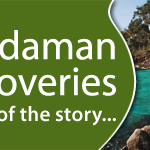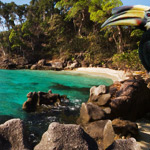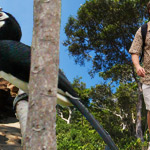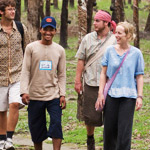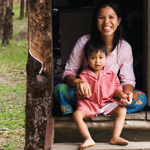Andaman Discoveries Blog
Tuesday, May 8, 2012
Life with the Moken in Tung Dap
Labels: activities, biodiversity, community tourism, community-based tourism, conservation, cultural tours, ecotourism, Moken
Tuesday, March 6, 2012
Environmental Education Show
Labels: activities, Andaman Discoveries, conservation
Wednesday, May 11, 2011
Community Garden
Homegrown is better
 The garden will provide herbs for the villagers and color sources for such as turmeric for the tie-dye group. And the mulched remains of plants used for tie-dyeing are used as compost for the garden. Plants in the garden include: lemongrass, ginger, turmeric, long bean, chili, galangal, kariyat, and elephant ear Watering in the dry season will be overseen by the tie-dye group.
The garden will provide herbs for the villagers and color sources for such as turmeric for the tie-dye group. And the mulched remains of plants used for tie-dyeing are used as compost for the garden. Plants in the garden include: lemongrass, ginger, turmeric, long bean, chili, galangal, kariyat, and elephant ear Watering in the dry season will be overseen by the tie-dye group.Before work on the community garden began, 5 elementary age kids and 5 preschool age kids participated in a “competition” to draw the garden of their dreams and explain why. The children then joined the adults to clear the area, till the soil, and plant the seedlings. After a follow-up weeding session with the Naucrates turtle team, the kids were rewarded with an evening party with project staff and foreign volunteers.
Thanks to Planeterra, Mangrove Action Project, and Naucrates for their partnership on this project.
Labels: community-based tourism, conservation, construction
Conservation in Action
Volunteer activity development

Community members have expressed a desire to host volunteers year-round, and requested help developing activities. At the mangrove study site, we set up a number of plots and transects and developed a detailed monitoring sheet for volunteers. These can be used by short-term visitors in cooperation with village guides. To ensure local understanding and participation, the forms include Thai and English.
Thanks to Naucrates, Planeterra, and Mangrove Action Project for their partnership on this project.
Labels: community development, conservation, Mangrove, volunteer
Wednesday, March 17, 2010
International Wetland Day
Governor of Ranong brings a big crowd to Laem Son National Park
The event showcased exhibitions by variety of organizations, a play about the wetland environment, and a forum regarding wetland habitat in the area and how climate change will affect it in the futre.The National Park released 50 sea turtles and 10,000 white snapper during the culminating group event, designed to raise awareness about key species that are vital to wetland and marine health.
Along with other wetland areas in Rangong, the Laem Son National Park officially became part of Ramsar Convention on Wetlands (Ramsar Site) in August 2002. The park is shaded by a mixture of mangrove and fir trees, transitioning into sandy white beach as it nears the ocean. The network of winding paths was dotted with presentation boards from community-based handicraft groups, conservation groups, and educational groups.
Labels: Ban Talae Nok, community, conservation, natural resource management
Water Lily Planting in Nakha
Nakha boasts stunning mountainous scenery, and is home to the highly endangered Water Lily, known locally as the "Yah Chong." This fresh-water plant has unusually long leaves and delicate white flowers that bloom from October to December. Unfortunately, the water lily faces serious threats from river dredging and collection for resale as aquarium plants.
To help save the Water Lily, locals formed a conservation group to protect its habitat, and now offer rafting excursions to raise public awareness of this beautiful plant. Profits are used by the club to pay for school trips. The club also sponsors a nursery that is used by the youth group for replanting the water lilies.
Labels: conservation, endangered species
Monday, February 1, 2010
Stories from the Field

Labels: community-based tourism, conservation, IUCN
Wednesday, January 27, 2010
Stories from the Field
 Ladda Aharn, or Pink, as her friends call her, smiles as she welcomes the group of tour operators to her village on the Andaman Coast. Unlike the majority of visitors over the past few years, this group of visitors is not here to see the destruction wrought by the tsunami of 2004. Instead, they are here as tourists to enjoy the cultural and natural splendor of Ban Talae Nok, a village of 67 homes situated in between the coral reefs and dense rainforests of Southern Thailand.
Ladda Aharn, or Pink, as her friends call her, smiles as she welcomes the group of tour operators to her village on the Andaman Coast. Unlike the majority of visitors over the past few years, this group of visitors is not here to see the destruction wrought by the tsunami of 2004. Instead, they are here as tourists to enjoy the cultural and natural splendor of Ban Talae Nok, a village of 67 homes situated in between the coral reefs and dense rainforests of Southern Thailand.Labels: Ban Talae Nok, community-based tourism, conservation, IUCN
Monday, January 25, 2010
Community Network - Profiles from the Field

Labels: community-based tourism, conservation, homestay
Monday, January 18, 2010
Appeal from Phratong Island
Conservation Partners Need your Help
 MAP, in partnership with Naucrates, have established a Coastal Community Resource Center (CCRC) in Ban Lion Village on Phra Thong Island. Take a moment to read their special appeal, and if you can, please consider donating or helping to spread the word.
MAP, in partnership with Naucrates, have established a Coastal Community Resource Center (CCRC) in Ban Lion Village on Phra Thong Island. Take a moment to read their special appeal, and if you can, please consider donating or helping to spread the word.The effectiveness of Andaman Discoveries requires cooperation from many partners at the grassroots level, including the communities, NGOs, and sustainable enterprises. Two organizations that have been essential to conservation successes in this remarkable area of Thailand are the Mangrove Action Project (MAP) and Naucrates Sea Turtle Conservation.
These organizations need your support to help preserve the extraordinary biodiversity found within coastal ecosystems of the North Andaman region of Thailand. This area is increasingly threatened by unsustainable natural resource exploitation and development, the impacts of which not only affect the unique natural flora and fauna of the area, but the local fishing communities as well. A very real need exists for increased environmental awareness and education at the local level to create and secure sustainable livelihoods.
Labels: Ban Lion, conservation, Mangrove Action Project, Naucrates
Community Network - Profiles from the Field
Alee Salee, Niyom Prai Group, Ton Kloy Village
 Born in a nearby village, Alee moved to Ton Kloy as a young man, and, for many years, supported his family by hunting wild animals. The forests surrounding Ton Kloy are renowned for rare plants, a great diversity of butterflies, and abundant wildlife. Over time, Alee began to understand that it was important “to protect the forest and keep wildlife in this area for people to see in the future.”
Born in a nearby village, Alee moved to Ton Kloy as a young man, and, for many years, supported his family by hunting wild animals. The forests surrounding Ton Kloy are renowned for rare plants, a great diversity of butterflies, and abundant wildlife. Over time, Alee began to understand that it was important “to protect the forest and keep wildlife in this area for people to see in the future.”While keeping a clear eye on the future, Alee is also addressing the pressing conservation problems of today. Along with other former hunters from Ton Kloy, Alee visits surrounding villages, and asks hunters to refrain from shooting the deer, gaur, serow, and other wildlife that come to Ton Kloy’s fruit orchards for food and water. Alee reports that his efforts have been successful in reducing illegal wildlife hunting; there are no longer any hunters in his village and five hunters from nearby villages have stopped poaching.
When his village formed the “Niyom Prai” conservation group in 2007, Alee was among the first to join. From the onset, the group has worked to develop the area’s ecotourism potential with a focus on jungle hikes, including a spectacular waterfall and an historical tin mine. The Tourism Club also engages in community service activities including trail maintenance, road side clearance, and rubbish removal.
“By successfully preventing hunting and forest encroachment in our village, we can then expand to other villages when they have seen the result,” Alee concludes, “going to hunt a deer we can feed only five or six persons, but if we keep a deer everyone can come and see it for a long time.”
Labels: community tourism, conservation, ecotourism, Ton Kloy
Wednesday, December 23, 2009
Tung Dap Homestay
by Noelle Smithhart
 After leaving the school, we spent two nights with a host family in Tung Dap, on Koh Phratong Island. This part of our voyage was filled with amazing beauty, gracious hospitality, and even more delicious food.
After leaving the school, we spent two nights with a host family in Tung Dap, on Koh Phratong Island. This part of our voyage was filled with amazing beauty, gracious hospitality, and even more delicious food. I wrote this while I was there. Words won't do the experience justice, but they are the only way I can convey the two days we spent there:
I am listening to conversations in languages I do not understand. The wind talking to the trees. The clucks of chickens and roosters beneath the beams of the house I am sitting in. The scent of onion, sizzling as our hosts prepare dinner. Children's brief calls. The silence of cats and dogs sleeping. The rumble of man and machine. The dash of geckos on the roof. I may not understand them, but knowing them, in this moment, gives me peace.We are in paradise. Where a flicker of light could be a spark on a tractor or a firefly. Where little boys catch bugs and give shells as gifts on long beach walks. Where the crescent moon catches where the
sunset left us on the last horizon. We can get lost in stars and styrofoam signs. The water is warm. Did you feel the foxtails tickle your arm? Did you let the sand fill between your toes? Did you breathe in the salty air? Breathing in and out with the currents.
May I remind you again that we are in paradise. Where bright eyes meet ours with smiles. Where the baby sits behind his father's wheel.
What woke you this morning? The far off fisherman's boats? Scooters? Ducks? The booming, buzzing sirens of the cicadas? Or did you rise when our host tossed the dry grains of rice in her pot? Did the alpha wake you with his growl? Or the roosters echoing each other's calls?
Yes.
As my eyes closed to rest on our mats, the vision of a miracle played itself out on the backs of my eyelids. My toes still felt themselves being sucked into the muck near the newly planted mangrove seeds. I feel the layer of fine sand coating my skin. And now we rise to Nescafe. Rice and shrimp. Folded mosquito nets and textiles. Let us never finish this conversation. As the sea gypsy "Noi" tone loops in our memories.
Labels: community service, conservation, homestay, Southern Thailand Volunteering
Friday, October 30, 2009
Life’s a Clean Beach
UK Family Supports Environmental Effort
 Andaman Discoveries and the village of Ban Talae Nok are extremely grateful to the Hannah Family (UK). Shortly after their recent village homestay, this benevolent family of four donated 10,000 Thai Baht (about $290) to the Ban Talae Nok Youth Group to support a regular beach clean-up effort. “We had such a fab stay at the village and thoroughly enjoyed the relatively unspoilt beauty of the coast there. We believe it would be a good thing, for everybody, if the beach was kept free of rubbish,” said Susan Hannah.
Andaman Discoveries and the village of Ban Talae Nok are extremely grateful to the Hannah Family (UK). Shortly after their recent village homestay, this benevolent family of four donated 10,000 Thai Baht (about $290) to the Ban Talae Nok Youth Group to support a regular beach clean-up effort. “We had such a fab stay at the village and thoroughly enjoyed the relatively unspoilt beauty of the coast there. We believe it would be a good thing, for everybody, if the beach was kept free of rubbish,” said Susan Hannah.Every two months the youth – armed with gloves and trash bags – will work their way down the beach picking up shoes, bottles, and plastic. The funding will also supply them with drinks and snacks. “Through just a little effort a few times a year, Ban Talae Nok will keep its stunning beach,” added Susan Hannah. “The Hannah family’s generosity reinforces the importance of keeping our beach clean and litter free,” noted an appreciative Ladda “Pink” Aharn, community coordinator in Ban Talae Nok.
Labels: Beach, charity, community tourism, conservation, Thailand tours
Conservation and Culture
Holiday Specials Showcase Region's Diversity
Planning to travel in Thailand this holiday season? Check out the expanded range of activities and villages available in this year’s special holiday tours. We’ve covered everything from reefs to rainforest and hikes to handicrafts! We invite you to explore the traditional culture and natural environment of the North Andaman region of Thailand--whether you’re traveling with family or exploring on your own, these special itineraries showcase the best of everything this unique region has to offer. Best of all, you will be helping local communities preserve their traditional culture and environment.
The spectacular natural beauty and cultural diversity of the North Andaman region make it a fascinating place to explore--the area boasts the largest concentration of mangrove forest in Thailand, as well as tropical jungles, beautiful beaches, coral reefs, and sea grass beds. It is also home to the rare dugong and the green turtle. No less diverse are the region's people: Muslims, Buddhists, and Moken Sea Gypsies all co-exist with their own unique cultures.
While many fishermen and farmers still make their living by traditional methods, much of the area's fauna and flora is under threat from habitat loss. In recent years local communities have realized the potential of sustainable tourism to negate these threats and conserve the ecological and cultural beauty of the region.
Contact us for more information about this special two-day adventure, or any of our Cultural, Family, or Hands-On itineraries today!
Can’t travel to Thailand but still want to support community conservation? Please consider purchasing a holiday gift from the Andaman Discoveries handicrafts store. We offer hand-made cards, Ban Talae Nok herbal soap, and hand-carved Moken boats. Proceeds help provide local people with a complimentary source of income while still continuing their traditional way of life.
Labels: community tourism, community-based tourism, conservation, Thailand tours
Polls Closing!

Thank you to everyone who has already voted for us in the BBC World Challenge -- we sincerely appreciate your support. “The BBC World Challenge is a chance for us to share the difference we are making. Whether it’s providing income to women’s handicraft groups or training the next generation of conservationists, community-based tourism allows visitors to enjoy the traditional Thai way of life, while helping to preserve the unique culture of our region,” Tui Chomphusri, Director of Andaman Discoveries, observed.
Voting is open until midnight (GMT) on Nov. 13. If you haven’t had a chance yet, please help us and take a moment and vote today!
The World Challenge is a global competition aimed at finding projects or small businesses from around the world that have shown enterprise and innovation at a grassroots level. Andaman Discoveries is one of 12 finalists is this competition. The winners will be announced in December.
Labels: BBC World Challenge, community-based tourism, conservation, Thailand tourism
Tuesday, June 16, 2009
Erik’s Adventures - Fragile Footing
Can Ecotourism Save the Ban Naa River?
 P’ Lek stares wistfully at the banks of the Ban Naa River, located about 65 kilometers south of Ranong, while he pilots our inflatable raft downstream. On our left is a large concrete tower -- formerly part of a suspension footbridge -- now toppled and half-submerged, enmeshed in a tangle of cables. The surrounding land has all been cleared, stripping its rebar-like root system; recent monsoon rains swept away the tower’s vulnerable footing. Across the river a lone tower stands sentinel amongst dense forest.
P’ Lek stares wistfully at the banks of the Ban Naa River, located about 65 kilometers south of Ranong, while he pilots our inflatable raft downstream. On our left is a large concrete tower -- formerly part of a suspension footbridge -- now toppled and half-submerged, enmeshed in a tangle of cables. The surrounding land has all been cleared, stripping its rebar-like root system; recent monsoon rains swept away the tower’s vulnerable footing. Across the river a lone tower stands sentinel amongst dense forest.Further downstream we anchor at an oxbow where rubber tree saplings cling dearly to the abrupt precipice; this year alone the river’s dimensions at this location have swelled by several meters through erosion. Lek and his team of five villagers set about measuring the damage -- river width and depth -- using rope, a plumb, a tape measure, a length of blue PVC pipe, and a camera. I’m one of several Westerners who have joined them on this rainy day -- including staff from Andaman Discoveries, N-ACT, and the Peace Corps -- to survey roughly three kilometers of the Ban Naa River and assess its eco-tourism potential.
 A few years ago this muddy, silted beach was lined with a protective canopy of native jungle, with an accompanying chorus of high-pitched locusts and birdsong. And as many years ago the mono-crop plantations of rubber and oil palm that now conspicuously abut upon the river were home to varied fruit orchards. A recent drop in fruit prices encouraged the switch from these crops. “I love this area and want to see it restored. I am hoping to use tourism as a tool to re-introduce sustainable agriculture to the area,” Lek told us.
A few years ago this muddy, silted beach was lined with a protective canopy of native jungle, with an accompanying chorus of high-pitched locusts and birdsong. And as many years ago the mono-crop plantations of rubber and oil palm that now conspicuously abut upon the river were home to varied fruit orchards. A recent drop in fruit prices encouraged the switch from these crops. “I love this area and want to see it restored. I am hoping to use tourism as a tool to re-introduce sustainable agriculture to the area,” Lek told us.The nickname Lek, which is the Thai word for small, is as incongruous on this imposing forty-something man with a wispy ponytail as his 4X4 racing t-shirt is to his ethos of conservation. His vision is to staunch the degradation of this area and eventually reverse it by reintroducing the cultivation of sustainable mixed agriculture through community-based ecotourism. With tourists paying to harvest fruit, he hopes to make this type of farming financially viable again. In addition, he’s launching youth conservation efforts to educate young people as to the value of conservation.
 At the next stop Lek harvests a few krai nam saplings. These trees have robust root structures, and Lek will re-plant them upstream in areas where the shoreline has been compromised by erosion. By relocating them upstream he also hopes that their seeds will eventually find purchase in soil further down. Such ideas are in stark contrast to the solutions employed by the mono-crop farmers, as I soon learned firsthand. At another stop, we anchor the raft along a desolate shore of dirt and stones. I jumped out of the raft and thought ground had been pulled out from under me – here the river had been dredged with a backhoe, forming a deep channel right up to the shore. This practice requires continual maintenance, and drastically increases silting problems downstream.
At the next stop Lek harvests a few krai nam saplings. These trees have robust root structures, and Lek will re-plant them upstream in areas where the shoreline has been compromised by erosion. By relocating them upstream he also hopes that their seeds will eventually find purchase in soil further down. Such ideas are in stark contrast to the solutions employed by the mono-crop farmers, as I soon learned firsthand. At another stop, we anchor the raft along a desolate shore of dirt and stones. I jumped out of the raft and thought ground had been pulled out from under me – here the river had been dredged with a backhoe, forming a deep channel right up to the shore. This practice requires continual maintenance, and drastically increases silting problems downstream.To be sure, Lek and his team face an uphill battle. There are powerful, well-financed forces at work in the area whose only concern is quick profits. But the optimism of Lek and his staff is contagious, and combined with the natural beauty of the area one cannot help but feel inspired by his team’s grassroots efforts.
In addition to the rafting trip, the area offers attractive ecotourism opportunities such as a short hike to a hot/cold spring and an overnight hike to the La Ong Dao waterfall. The village of Ban Naa also offers visitors the opportunity to engage with the monks of a forest temple and the chance to learn from local artisans whose handicrafts include weaving and making rattan furniture.
For more information about Ban Naa, please contact Nat at info@andamancommunitytourism.com
Labels: agriculture, conservation, ecotourism, erosion, mono crop, rafting, sustainability
Drafting the Next Chapter
Team Andaman Looks Inward and Onward
 An unexamined life is not worth living, said Socrates more than two millennia ago, and, like life itself, the complexities of community development and conservation also require an introspective spirit. With that in mind, Andaman Discoveries dedicated the entire last weekend of May to a working staff retreat.
An unexamined life is not worth living, said Socrates more than two millennia ago, and, like life itself, the complexities of community development and conservation also require an introspective spirit. With that in mind, Andaman Discoveries dedicated the entire last weekend of May to a working staff retreat.Teamwork was the common goal, from the opening icebreaker in which everyone bunched together in a circle, then bent down and attempted to walk as one, to a finale of “Twister!” For the two days in-between the team worked as one, reviewing the Andaman Discoveries’ mission statement, organizational chart, and everyone’s individual contributions, with fresh feedback and ideas. The retreat was intense at times, as everyone delved deep into planning and direction. But with expert facilitation from seasoned veteran and friend Bill Tuffin, a firm team commitment, and a common vision of future viability, amorphous ideas crystallized into firm plans and clearer roles.
 The retreat was held in Khao Sok National Park at Our Jungle House, which is nestled amongst 25 acres of idyllic lush rainforest bordering the Sok River and soaring limestone cliffs. This was the natural choice for the retreat due to its peaceful setting, open working space, environmental philosophy, and proximity to Kuraburi.
The retreat was held in Khao Sok National Park at Our Jungle House, which is nestled amongst 25 acres of idyllic lush rainforest bordering the Sok River and soaring limestone cliffs. This was the natural choice for the retreat due to its peaceful setting, open working space, environmental philosophy, and proximity to Kuraburi.As anyone familiar with Andaman Discoveries knows, we work hard and play even harder, and by late Saturday afternoon serious fun was in order! The team hopped on inner tubes and plunged into the Sok River for a long, relaxing ride. The day’s intensity quickly dissolved in the crystal-clear mountain water. “It was stunning to be floating down a river in an inner tube with the rising moon and limestone cliffs looming above” said Leslie Welshimer.
Those with an insatiable appetite for adventure indulged in an encore trip, and were treated to perhaps the highlight of the weekend. At one point a bamboo shoot cantilevered over the river, on which a family of monkeys was foraging. We silently glided underneath just as the baby leapt through the air onto its mother’s back. Papa meanwhile dangled from the pole while fixing the spellbound tubers with a cautious simian gaze. The poignant encounter with nature was a reminder of why responsible tourism is important, and was one of those magical moments in Thailand that force one to pause and wonder, Is this a dream?
Labels: conservation, jungle, Khao Sok, monkey, Thailand
Monday, April 20, 2009
Fragile Earth
Getting back to sustainable agriculture
 Monoculture farming is transforming the landscape of rural Thailand. As part of our growing community tourism network, a number of our village partners recently visited northern Thailand, where they learned about the all-too-common shortcomings of monoculture.
Monoculture farming is transforming the landscape of rural Thailand. As part of our growing community tourism network, a number of our village partners recently visited northern Thailand, where they learned about the all-too-common shortcomings of monoculture.The group heard a poignant story from Sud, a small-scale plantation-owner who used to farm cassava root (most famously used in tapioca). For years he struggled to make a livable wage, strained by the high costs of industrial fertilizer and seeds required to sustain this nutrient-intensive crop. After a drought wiped out his crop, he lost everything. Fortunately, training from a local NGO helped redirect his agricultural skills, and he now manages a local community organic farming group. Sud and his group demonstrated how to use bio-fertilizer and employ various organic farming techniques.
The week-long study trip was packed with informative seminars about how to manage sustainable livelihoods and healthy ecosystems. Participants learned about coastal ecosystems, eco-tourism, organic farming, natural resource management, community welfare, and management of foundations and government. The trip provided an opportunity for participants to see models from other communities in the Kuraburi area all the way up to sites in northern Thailand.
Director Tui Chomphrusi represented Andaman Discoveries at the study trip. She remembers a particularly moving and universally-resonant remark from Anan Duangkaewrueng, a former government official turned activist in Chiang Mai: “The answer is not from government, the answer is from community.”
Labels: conservation, monoculture farming, Thailand
Subscribe to Posts [Atom]

